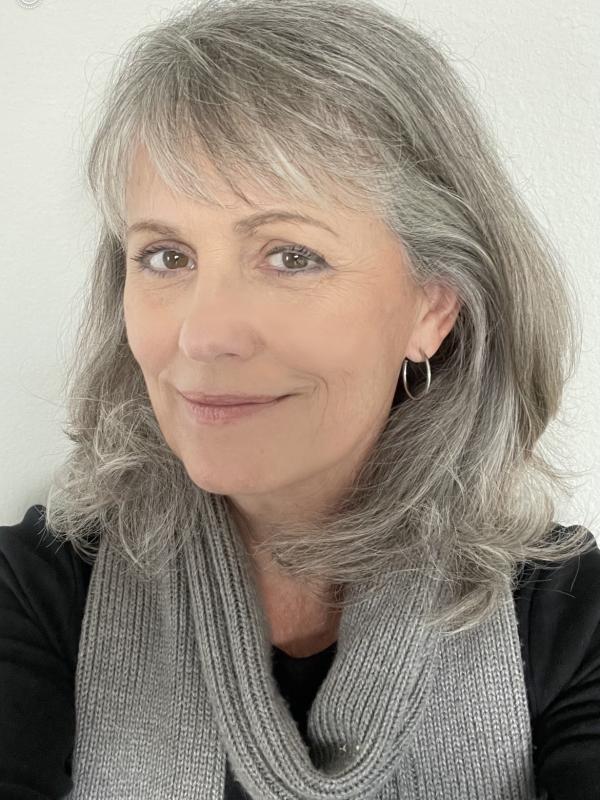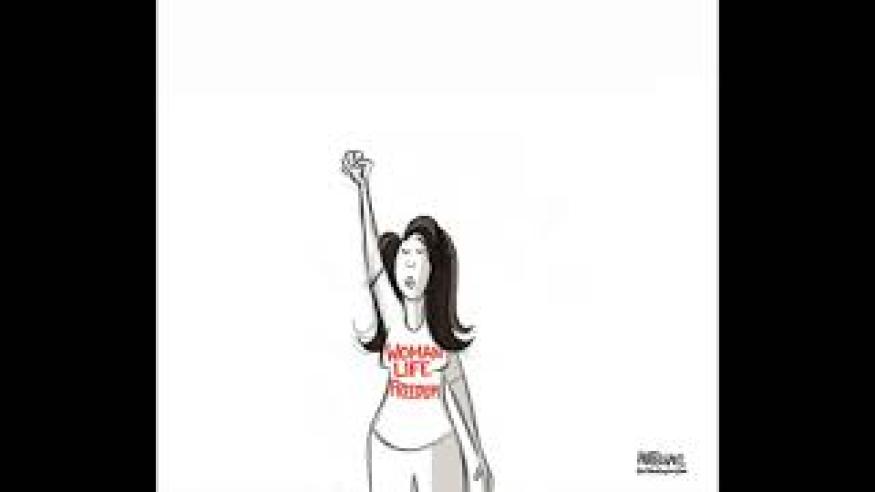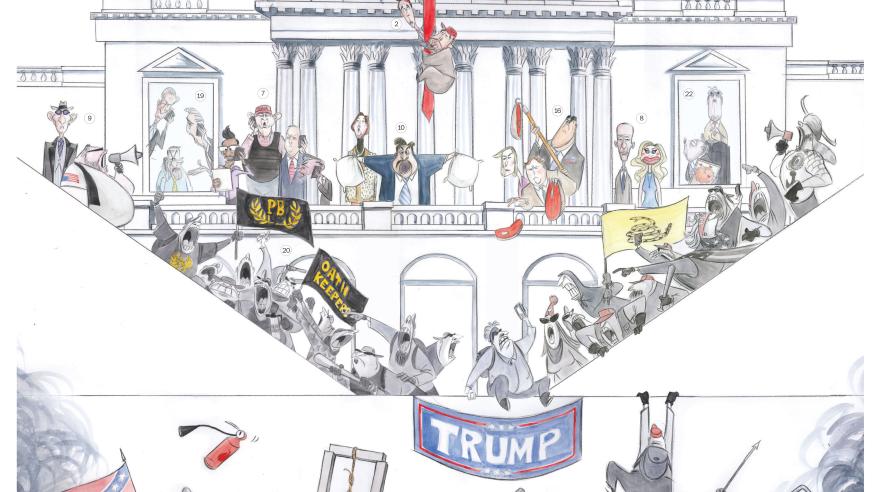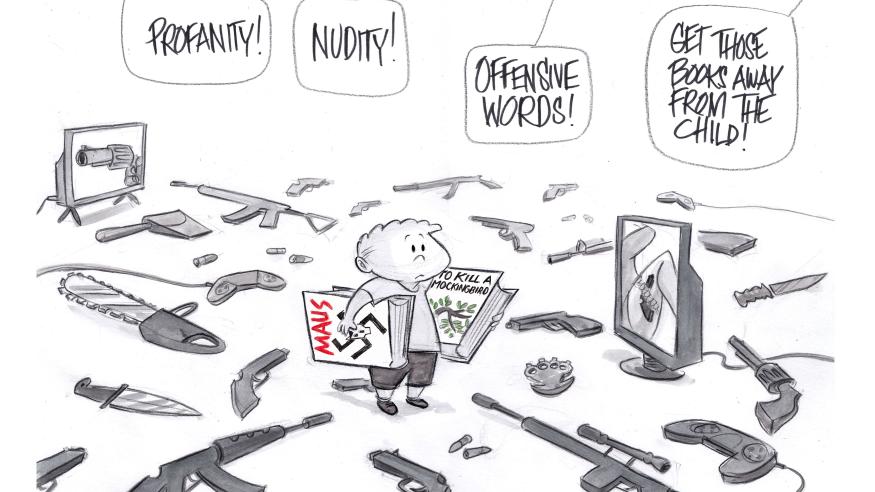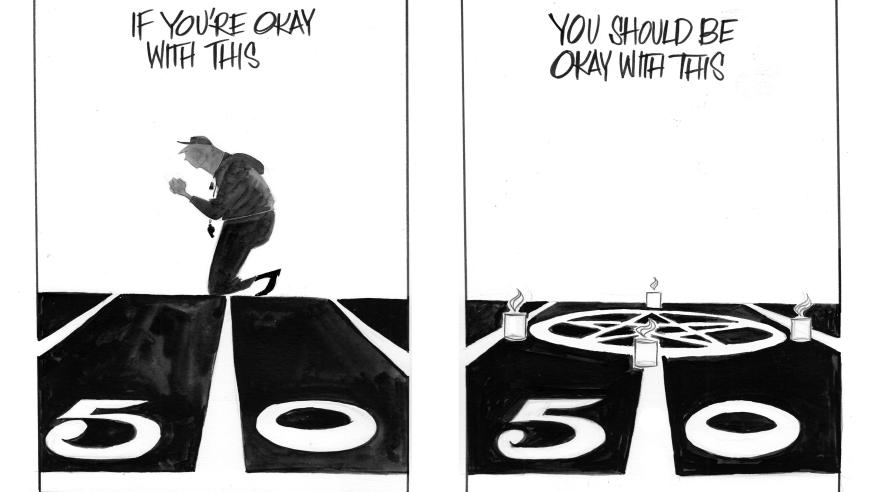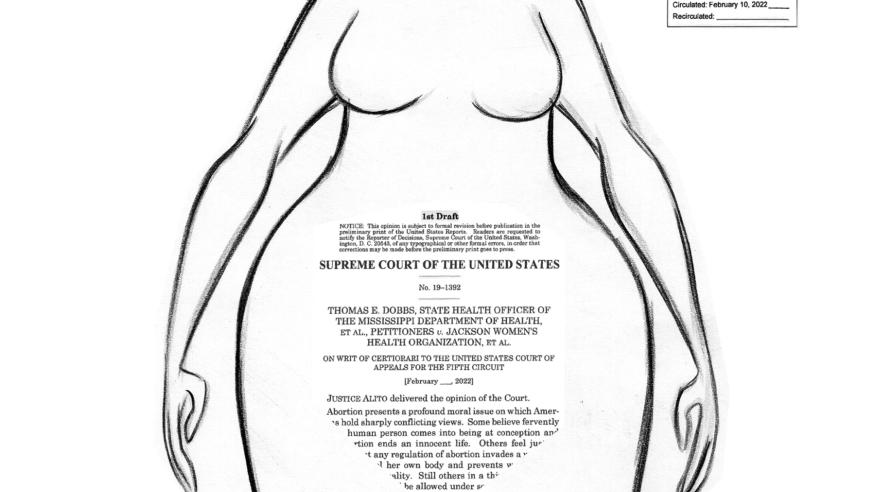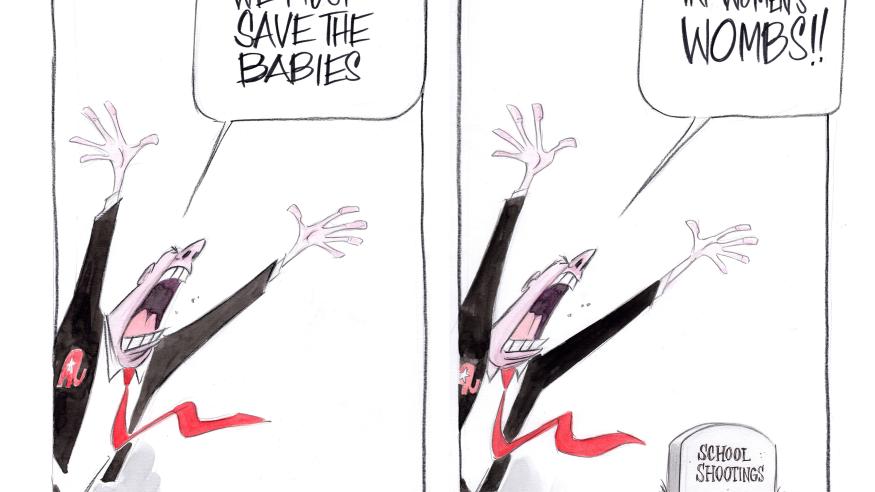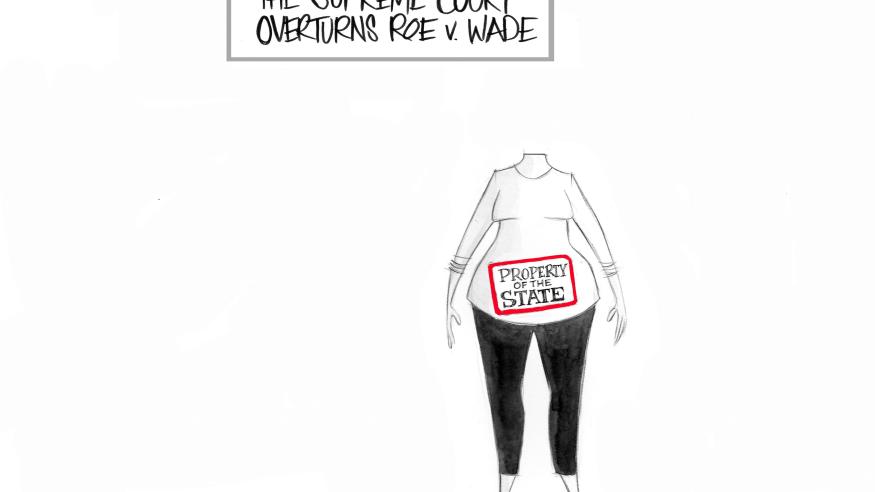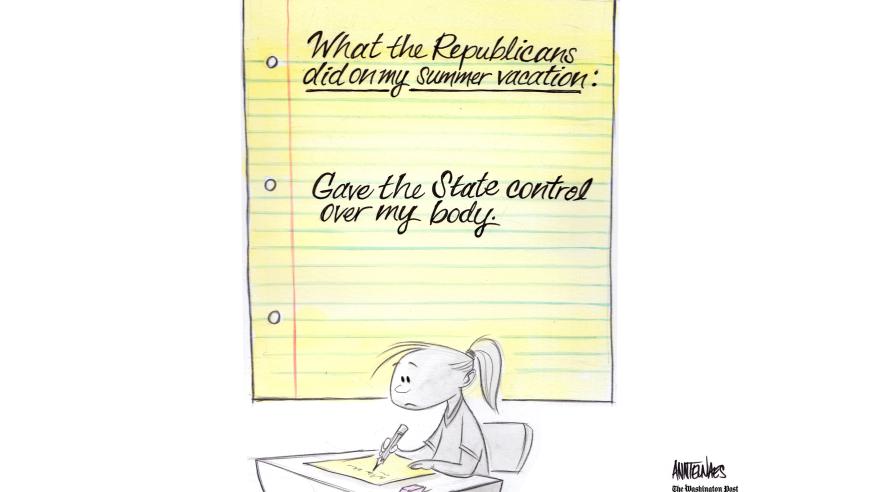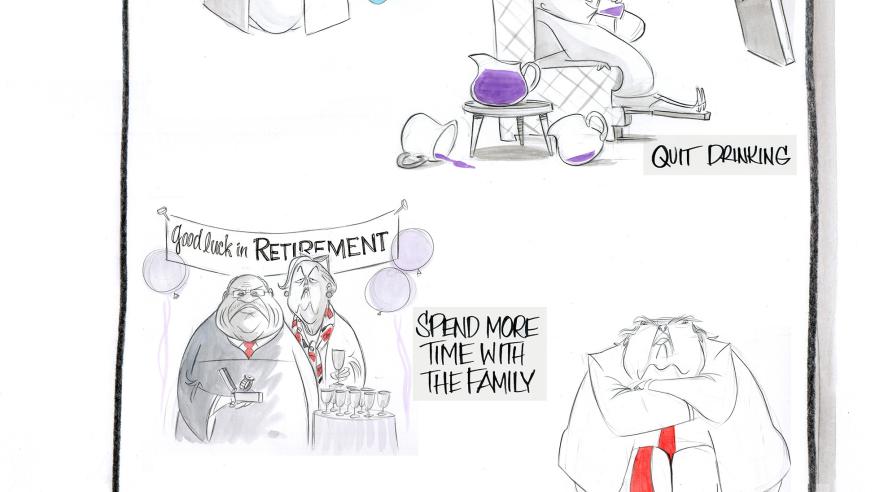"Obviously I was thrilled to receive the news that I was this year's winner of the Herblock Award but I was almost just as thrilled to hear who the keynote speaker would be—Representative Jamie Raskin. And then I was really relieved when I heard that my speech would not follow his.
I'd like to begin by saying that I cannot overstate the importance of the Herb Block Foundation for the editorial cartooning community. Their steadfast support of editorial cartoonists is immensely appreciated by me and my colleagues. They value this art form and understand how essential it is that editorial cartooning thrives for the health of a democracy. So please join me in a very loud round of applause for the Herb Block Foundation.
I'd like to also thank the judges. They are all very talented and accomplished cartoonists and committed to holding our profession to a high standard. So I am sincerely humbled that they would choose me to receive the award this year.
I want to thank The Washington Post for allowing me such an incredible platform these past 15 years. I hope my work has done them—and Herblock—proud.
I'd like to acknowledge my Washington Post colleagues—design director Chris Rukan and the young genius coder Yan Wu—who worked with me on the multi—caricature interactive January 6th piece, which you'll be able to see upstairs during the reception. The impact of that piece wouldn't have been possible without their creativity. Besides being both very talented, they're also a joy to work with. Thank you Chris and Yan.
I'd like to thank my cartooning colleagues for their support throughout the years during difficult times and cartoon controversies. There's a lot of different personalities and temperaments in editorial cartooning but they're a great group of guys—and they are mostly guys—and I appreciate their friendship.
Thank you to my gal pals for being here.
Beth, who's here with her son Arturo. Beth and I go way back—all the way to high school. Beth is the one who will text me a heads up about some breaking news after which we'll exchange a flurry of outraged messages. She'll also send me links to the latest Randy Rainbow videos.
Mona—who was my classmate in the character animation program at California Institute of the Arts. Mona was also my colleague and officemate at Walt Disney Imagineering, where we were both young show designers. I have many fond and funny memories from that time with her. One was developing the concept for a Disneyland ride based on the character Baby Herman from the animated film, "Who Framed Roger Rabbit". Our idea included a large imposing nurse yielding a gigantic syringe as you whizzed by in your ride vehicle. Probably needless to say, Disney never built that one.
Thank you to Signe and Barbara. In addition to being good friends, they have also been an inspiration for me and other women cartoonists.
And thank you to Gary—not a gal pal—for his support... and for traveling all the way from Seattle to be here.
I'd like to acknowledge the runner up of the Herblock Award, Michael Ramirez. Mike is an excellent draftsman, a nice guy, and I don't agree with him on just about everything. But I don't feel the need to physically attack him or demand his employers fire him. Which unfortunately a great many people nowadays think is an appropriate response when someone writes or expresses an opinion which they disagree with or are insulted by.
Democracy is under attack, and it's not just by guys with dead animals on their heads, ex—presidents, or Supreme Court justices. It's intolerance—people looking to impose their beliefs on others. Limiting speech and expression, and the right to make decisions about your own personal life. We have book bans—book bans— at an alarming rate in our schools. Pen America recently published a report showing an escalation of book bans and censorship during the first half of the 2022—23 school year. Speakers are being shouted down at universities rather than having a rigorous debate. And cartoonists are being silenced because of social media mobs and special interests who completely misread cartoons either because they don't understand the visual language or worse, because they are purposely trying to change the narrative.
And specifically because of the visual language we use, cartoonists will always be first in the line of fire. Why do cartoons cause such a visceral response? Because cartoons are universal. Every human being responds to these seeming simple drawings. They transcend language and class. Everyone, from the highly educated to the illiterate, can relate and see themselves in cartoons. Editorial cartoons can be subtle, cutting or humorous, but they also can be visually disturbing depending on the subject matter. And if an editorial cartoon is good, it has a strong point of view, makes the reader think, and challenges the status quo. Cartoonists are a barometer for all our free speech rights. A silenced cartoonist—and that includes when a cartoonist feels the need to self—censor because of intimidation or threats—a silenced cartoonist is an indicator of an unhealthy democracy.
Throughout the world cartoonists are targeted for their work. Organizations like Cartoonists Rights Network International and their partner Freedom Cartoonists Foundation, monitor and assist cartoonists who are under threat of violence or imprisonment. Among the cartoonists these organizations are watching are:
Malaysian cartoonist Fahmi Reza, who is best known for depicting a former prime minister as a clown. He has been detained and investigated under Malaysia's sedition and multimedia acts for his criticisms of government officials and members of the Malaysian royal family.
Another cartoonist being monitored is Wimar Fuentes. Wimar has denounced and challenged the Cuban government in his work for years and is now displaced and under threat of imprisonment.
Turkish cartoonist Zehra Ömeroğlu, whose so—called "obscenity" case comes to court in May over a cartoon which was meant to make people laugh during the early days of the covid pandemic lockdowns. She is now facing possible imprisonment.
And Tanzanian Opptertus Fwema, whose home was raided while he was held for an illegally long time over an Instagram post in 2021 He was finally acquitted last year only to be immediately arrested again.
While these cases might seem distant to us sitting here with our First Amendment protections, it's not an abstraction. This country's own growing intolerance of freedom of expression and deliberate spreading of misinformation is a worrying indicator of what could come.
****************************************
I came to editorial cartooning late, I was just shy of thirty. My original plan was to enter the animation profession. I had studied to be a character animator and went on to work in the field for several years. I just wasn't interested in politics . But then something happened which changed my direction. I was working late one night in 1989 on a freelance project and, as I usually did, had the tv on as background noise while I drew. The Tiananmen Square Massacre unfolded live right in front of me. I was shocked and horrified that a government would kill its own young people. Maybe the reason it had such an impact on me was because I was close to the ages of the protestors but I immediately put my deadline aside and created my first editorial cartoon.
From then on, I regularly read newspapers and watched the news. I became addicted to c—span. I continued to draw occasional editorial cartoons, but just for myself—I didn't try to get them published. And then, in 1991 I watched the Anita Hill/ Clarence Thomas hearings. As a young woman who had dealt with sexual harassment and discrimination, watching all those senators—both Republicans and Democrats—not believe Anita Hill, infuriated me. I decided right then and there to put together a portfolio of cartoons and send them out to newspapers throughout the country. Good thing I didn't know anything about the newspaper business or that the overwhelming majority of ed cartoonists were men.
Fast forward almost 30 years later and I'm an editorial cartoonist working for The Washington Post and watching the Kavanaugh hearings. And nothing has changed.
I am happy to say though, that things have changed elsewhere. There are many more women participating and being recognized in the larger cartooning profession, although there are still not many women editorial cartoonists in this country. But the past few years I've been teaching a college class about editorial cartooning and women make up the overwhelming majority in all my classes. And they are engaged and motivated. Now, if women could just achieve pay parity and stop being passed over for top cartoonist positions on major papers then we'd be getting somewhere...
**********************************
I'll end with what has become sort of a tradition for the year's winner, which is to recall meeting the great cartoonist Herblock. As time goes by though, there are fewer and fewer cartoonists who have but I've been around long enough to tell you one of those stories.
Like several of my colleagues, I have been the recipient of Mr. Block's kindness. Soon after moving to DC I got a chance to meet him in person at the old Washington Post building. And yes, I recall his office being as messy as the photos you've seen. He gave me his latest book about his cat Bella and charmingly inscribed "To Ann Telnaes, a peachy cartoonist, with best regards, Herb Block".
He saved tear sheets of my work for me whenever he came across them in some small publication. He didn't hesitate to critique my cartoons when he thought the muscles in an arm had been drawn incorrectly. He must have kept late hours because I remember once waking up in the middle of the night when my answering machine went off and there was Herblock's voice saying something about tear sheets. But my favorite message from him came in the form of a fax. It was 2001 and I had just won the Pulitzer Prize for editorial cartooning. Oh his Washington Post letterhead, Herblock wrote in big capitol letters a one—word message : "YAY!"
Thank you, Herb Block—and a big "YAY" back 'atcha."
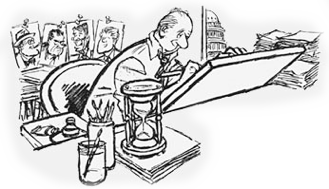 Herb Block is among the world’s best known and most admired political cartoonists. Born on October 13, 1909, the native Chicagoan spent his 72-year career fighting against abuses of the powerful.
Herb Block is among the world’s best known and most admired political cartoonists. Born on October 13, 1909, the native Chicagoan spent his 72-year career fighting against abuses of the powerful.
